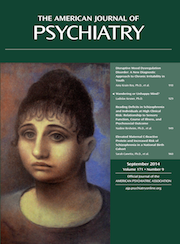Managing the Side Effects of Psychotropic Medications
I had the good fortune to be referred to a new text, published by American Psychiatric Publishing, titled Managing the Side Effects of Psychotropic Medications, by Joseph Goldberg, M.D., and Carrie Ernst, M.D. This work is a gold mine of information that is both scholarly, with extensive references, and clinically invaluable. To be honest, I was quite excited to run into this work, and I plan to have it with me in our resident training clinics. As the authors state in the opening section, the growth of pharmacologic options in psychiatry over the past decades in our field is inspiring, as they offer a means to help with most all psychiatric conditions. “Yet, despite the fervor with which psychiatrists often devise complex drug regimens or undertake novel pharmacotherapies for conditions that respond poorly to traditional agents, many practitioners are often remarkably uncomfortable confronting and managing unintended drug effects” (p. 4). I concur with Dr. Michael Gitlin’s review of this book: “It is a book that will remain on my desk, not my bookshelf.” I imagine referring to this work when in our pharmacology clinic and psychiatric emergency department providing consultative care while simultaneously teaching trainees.
I was quite taken by the opening chapters of the book. The authors make the point that it is critical for the psychiatrist, often working hand in hand with a primary care physician, to have the competency to consult on issues of side effects of medications. Yet, this is often difficult. Discerning the likelihood that a symptom is a side effect and not a component of the disease process itself is at times complicated. Furthermore, if in fact it is a side effect of a psychotropic medication, is it likely to go away? Will it improve with a lowered dose? This book goes to great lengths to answer these and equally complex questions presenting both a paradigm to consider the questions and data to support decision-making processes.
I was delighted to see so many useful charts and tables throughout the text. For example, “medical conditions that may contradict specific psychotropic agents,” a list of medical conditions and medications contraindicated in these situations; “routine laboratory monitoring for commonly used psychotropic medications,” specific information for prescribers regarding essential laboratory data for medications we commonly prescribe; a table of “common side effects with dose relationships reported by manufacturers from Food and Drug Administration registration trials”; and a table of “black box warnings” for commonly prescribed psychiatric medications. Any educator in our field will want to make copies of these to distribute as learning tools for trainees at any level.
The book goes on to delineate properties of pharmacokinetics and then to outline specific vulnerable populations with regard to drugs in question, with specific dosing suggestions in these populations. I was perhaps most taken by chapter 4, a fairly thorough synopsis of psychiatric side effects seen in nonpsychiatric medications. A practitioner desiring to deepen his or her knowledge in this area will want to read this section through. It also serves as a desk reference for the psychiatrist treating patients on multiple medications—the common scenario for most of us in practice. This section also serves as an outstanding review for anyone preparing for Board certification and desiring to find a place where this information is consolidated!
The text then goes on to delineate how various psychiatric medications may have an impact on specific organ systems. These sections are a powerful augmentation to available information systems when treating patients in our consulting offices. Each chapter serves as a unique potential learning experience. A review of chapter 7 addressing the cardiovascular system gives the reader an idea of the breadth of this work. This chapter begins by outlining the basic mechanisms of arrhythmias and then provides a table of psychotropic medications and potential electrocardiographic changes. The text then reviews the potential arrhythmogenic potential of specific antipsychotic, antidepressant, and stimulant medications. The section provides a detailed review of dyslipidemias, with tables including both the potential change in cholesterol and triglyceride values with specific second-generation antipsychotic medications. There is even a table of all cholesterol-lowering agents, with dosing parameters and potential common adverse effects. The authors also review cerebrovascular accidents, edema, hypertension, myocarditis, orthostatic hypotension, and the potential for various psychotropic medications to contribute to these adverse effects. A similarly clinically useful review is found about most all organ systems in other chapters of this text.
Any psychiatrist would welcome the availability of this text as a quick reference in the day-to-day practice of psychopharmacology. This book unlocks many mysteries of adverse effects and allows the psychiatrist to become immediately knowledgeable about most all side effects presenting in the office. Psychiatric trainees will simply devour this information. I can imagine our residents in their second year of training each taking a section of the text and becoming a master, teaching their peers each week in a didactic seminar that they run. This component of the curriculum just might be among the most popular in a psychiatric residency training program, and I plan to initiate just such a course in our program at the University of New Mexico. Thank you to Drs. Goldberg and Ernst for such a scholarly and clinically useful cannon!



